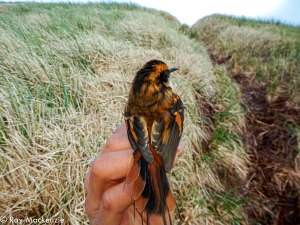The description of the new species identified as Subantarctic Rayadito (Aphrastura subantarctica), was published in the international scientific journal of Nature “Scientific Reports”, an article that presents the result of the research carried out over six years by researchers from the Cape Horn International Center for Studies of Global Change and Biocultural Conservation (CHIC), a baseline project funded by the National Research and Development Agency, ANID, which develops scientific studies with application for conservation in the Cape Horn Biosphere Reserve.
The team of researchers was led by the director of CHIC, an ecologist and academic from the University of Magallanes (UMAG) and the University of North Texas, Ricardo Rozzi, along with Claudio Quilodrán, Esteban Botero Delgadillo, Constanza Napolitano, Juan Carlos Torres Mura, Omar Barroso, Ramiro Daniel Crego, Camila Bravo, Silvina Ippi, Verónica Quirici, Roy Mackenzie, Cristián Suazo, Juan Rivero de Aguilar, Bernard Goffinet, Bart Kempenaers, Rodrigo Vásquez and Elie Poulin, the latter director of BASE Millennium Institute.
Many of them carried out their work in the area of the Diego Ramírez Islands archipelago, especially on Gonzalo Island, located south of Cape Horn, just over 800 kilometers south of Punta Arenas, sailing through the channels.
The subantarctic rayadito is distinguished from the species of thorn-tailed rayadito (Aphrastrura spinicauda) that inhabits the southern forests of Patagonia such as those distributed on Navarino Island, in Puerto Williams, where they nest in tree cavities. This new species nests on the surface in the middle of the grass and its morphological appearance is more robust with a weight of approximately 16 grams (in comparison to the 12 grams thorn-tailed rayadito ), with a larger bill, a longer tarsus and a shorter tail. Also, they move shorter distances from ground level and fly shorter distances. The habitat that the new species faces is extreme, with gusts of wind that normally exceed 100 kilometers per hour.
The area is of great interest for marine conservation and access for research has been provided by the Chilean Navy, in a research and sovereignty alliance that has been developed for more than 20 years in the area. There the researchers have developed successive campaigns being transported by Navy ships where the institution maintains the lighthouse that is inhabited by naval personnel.

The academic from the University of Magallanes and the University of North Texas, as well as director of CHIC, Ricardo Rozzi, stressed that “this research has been like an obsession to understand how a bird, which lives in the habitat of forests, which has the habit of life of feeding on the trunks and branches, of nesting in trunk cavities, how does it come to live in this case in a place where there are no trees, no bushes and no woody species, literally in the middle of the ocean a forest bird has managed to survive.”
“The Diego Ramírez Islands are still very little known by Chilean society, and this small endemic bird will be a symbol or emblematic species that will contribute to the knowledge for the country’s culture. We will continue to develop knowledge, appreciation and protection of this archipelago with the scientific leadership of UMAG in a collaborative effort with the Regional Government of Magallanes, the Navy and other public institutions”, said Ricardo Rozzi.
The biologist of the University of Chile and linked to the CHIC, Rodrigo Vásquez, a specialist in birds, says that “now this species has been found, which was described in very basic literature, as belonging to the same Thorn-tailed rayadito, but thanks to a slightly deeper study, we were able to genetically see that it differs in a mutation from the rest of the species of the classic Rayadito, in addition to morphological and behavioral differences”.
There are some individuals with little genetic difference on Cape Horn Island. Its morphological features stand out, such as its larger legs, greater body weight and shorter tail, which does not seem to make it a great flier given the high winds in the Diego Ramírez Islands, where the vegetation is low and the nests are made at ground level as they detected it.
The researcher Constanza Napolitano, an academic from the Department of Biological Sciences and Biodiversity at the University of Los Lagos, in Osorno, recalls that she led part of the genetic analysis, while another part was addressed by Esteban Botero’s group. She highlights the collaborative work carried out between different researchers who contributed to reach these results, and the approach to the scientific question in an integrative way from different angles and complementary methodological approaches.
The University of Magallanes rector, José Maripani, highlighted this work and stated that “this shows the importance for the Region of Magallanes and Chilean Antarctica, and for our country and the world, that a new species of land bird is identified that inhabits further south of Cape Horn and at the same time how transcendent are the conservation initiatives such as the Diego Ramírez- Drake Passage Marine Park for the conservation of different species and where UMAG has worked on the proposal of the general administration plan of that marine park.
By: Cape Horn International Center, CHIC
Main photography: O. Borroso and R. Mackenzie

